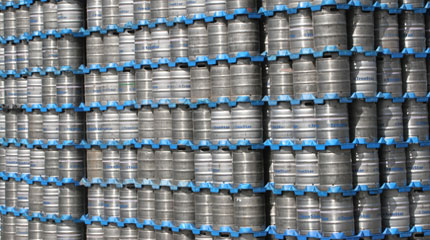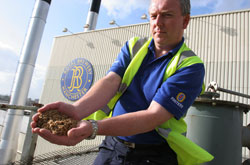
Archive content: last updated 13 July 2007
The Royal Brewery, in Moss Side, Manchester (the home of Fosters, the second biggest selling lager in the UK) is well over a century old, but is now years ahead of its competitors in dealing with the energy used on site.
Scottish & Newcastle, the company who own the brewery, are installing a 4.7MW combined heat and power (CHP) plant fuelled entirely by biomass. They will take a by-product of the brewing process, the spent grain, and use this as one of the primary fuel sources for their CHP plant. The site produces 42,000 tonnes of spent grain every year, which could provide 27 per cent of the total energy output from the CHP.
The grains will be pressed on-site to reduce the moisture content before being used as a fuel source. The pressed water will be treated in the site's effluent treatment plant, producing biogas (basically, renewable natural gas) to be used in another biogas CHP engine that will be installed. This will supply about 15 per cent of the brewery's total gas use. Considering the brewery spends £1.5 million on gas every year, the savings from producing biogas can be substantial if gas prices rise.
 The spent grain also has a high phosphate content so the ash from the biomass furnace will be sold as fertiliser.
The spent grain also has a high phosphate content so the ash from the biomass furnace will be sold as fertiliser.
Other fuel sources include untreated, used wood (33,000 tonnes a year), spent grain from some of their other breweries and prunings from apple orchards in Herefordshire. Future fuel sources could include yeast, effluent treatment sludge (from the water treatment plant that produces the biogas) or tank bottoms that are currently transported from site for disposal.
The CHP plant will supply 60 per cent of the site's steam (used in the brewing and packaging processes) and almost all of the electricity for the brewery.
The investment has sound commercial and operational advantages for the brewery. It will decouple the brewery from the fossil fuel market and reduce their carbon footprint by 25,000 tonnes per year: an 87 per cent reduction in emissions from fossil fuels. It also improves the brewery's security of supply for heat and electricity, hedging exposure to the volatile energy markets that could drive up the cost of our beer.
There's more still to come; the brewery plans to investigate the possible recovery of low grade heat from flue gases, the biogas engine and other areas of the site. It is hoped that the surplus heat could then be used to supply a local district heating scheme on the neighbouring Longsight estate, where there is already a district heating network installed.
Scottish & Newcastle have recently decided to use the same energy model across their breweries, including the 150 year old Tadcaster brewery, the home of John Smiths bitter. This brewery will now have a biogas digester for effluent treatment, a biogas engine to burn the gas and a CHP plant powered by the spent grain and locally-sourced waste wood.


